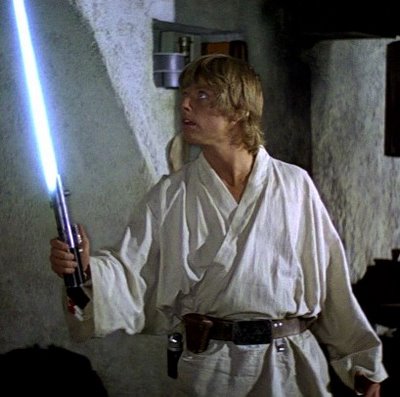
Star Wars is a space opera; that’s the most accurate single label for the genre in which the films, the majority of the stories, and the Star Wars universe in general fall. Yet space opera is itself a syncretic genre, drawing from a wide variety of pulpy story elements and templates to tell adventure stories in space. The term that “space opera” has largely displaced, “science fantasy,” is even more telling of the genre’s natural hybrid status. The trappings of science fiction are used, but not to examine the relationship between man and technology, or to illustrate truths about humankind in the way traditional science fiction attempts. Instead, they are used in the service of fantastic adventures in synthetic settings that can incorporate influences from a wide mixture of genres.
A New Hope serves as a solid example of the complex mix of genre elements present in the Star Wars setting. Luke Skywalker is a farm boy called upon to take up a mystic destiny among an order of knights who wield both swords and magic powers. This is unmistakably the stuff of fantasy. Yet he is also a farm boy living in the middle of a desert with his hardscrabble aunt and uncle, surrounded by hostile natives. His journey to his fantasy destiny involves going into town after the farm is burned down, striding into a cantina, getting in a bar fight with a couple belligerent outlaws, and taking up with a quick-drawing, bounty-hunter-dodging maverick with a heart of gold who is only a ten-gallon hat away from looking like a Wild West cowboy. It could be the start to a classic Western. Luke’s social life — going into town to bum around with his friends, tinker with hot rods, and race them — is taken straight out of the 1950s/60s teen flick genre, films like Lucas’s own nostalgia piece American Graffiti. The climax of the film is directly based on World War II war movies. The overarching storyline and setting are classic space opera, but by nature the genre enfolds other settings, both as influences to the core components of setting and story and as a sort of spice flavoring the story around the edges or influencing the way certain elements are depicted.

The films demonstrated that the space opera genre was broad enough to encompass other styles of storytelling. The Expanded Universe has run with that breadth, drawing from all kinds of genres. It has even openly dabbled in genre crossovers that more directly and completely place genre stories into the Star Wars setting, such as Joe Schreiber’s zombie horror novels, the “Star Wars Goosebumps” series Galaxy of Fear, and the tragically-canceled “James Bond meets Star Wars” Agent of the Empire series. Since the very beginning of the Expanded Universe, when Han Solo and Chewbacca reenacted the plot of The Magnificent Seven on Aduba-3, only for the climax to involve fighting a giant monster alongside a Don Quixote stand-in, the EU has incorporated a stunning range of other genres into the Star Wars universe.
My goal is to use this post as a launchpad for a series of posts examining Star Wars’ relationship with various genres, both in the ways genre has been used in the past and the potential I see for future stories. My primary interest is in ways the Expanded Universe can tell more kinds of stories, but with the news that “spinoff” Star Wars films are in the works, there is also potential for the films to approach different storytelling genres as well. I hope that you’ll join me on this ongoing look at Star Wars’ genre complexity.
